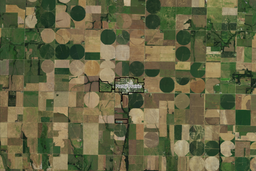Undermining the Upper Peninsula
The Chippewa take a stand against the return of mines to Michigan.
John Collins

If international mining companies could cash in on the division they’re fomenting in rural towns around Lake Superior — by, say, selling China the metric tons of animosity each new mine proposal generates — they could hang up their shovels and move to Tahiti. Where proponents of new mining projects see much-needed jobs and municipal revenue, opponents, like the 11 bands of Lake Superior Chippewa, see politicians catering to an industry that could cause irreversible harm to the region’s land and water.
In the previous issue of In These Times, I covered the fight over a proposed iron mine in Northern Wisconsin’s Penokees, the headwaters of Lake Superior’s Bad River.. To the east, in Michigan’s Upper Peninsula (UP), local Chippewa are engaged in a struggle against multiple new mines. But in the UP, a combination of historical mining nostalgia and a friendly regulatory climate have given mining companies the upper hand. Aside from two currently operating iron-ore mines, Empire and Tilden, at least eight foreign mining companies are actively exploring the Western UP and three sulfide mining permits have been issued since 2007.
Unlike the sparsely populated and spread-out communities of Wisconsin’s Northwoods, towns in Michigan have a history of large-scale industrial mining. “Yoopers,” as the folks in the UP are known, get their local news from papers with names like the Mining Journal and the Daily Mining Gazette. Since the 1850s, the ebb and flow of the region’s population can be tied to the extractive industry’s on-again-off-again presence. The copper rush spiked in the 1920s and ended in the 1960s, when the expense of underground mining outweighed its payoff.
In the decades following this “golden age” of mining, miles of contaminated waterways and schools of tumor-riddled fish were traced back to abandoned disposal sites and the piles of processed rock that mining companies left behind. Tourism, education and agriculture has picked up much of the economic slack the industry’s departure generated, but growing demand from China, India and other industrilizing nations has brought international interest in the region’s remaining copper and nickel deposits, fueling a new rush and the environmental risks that come with it.
The damage wreaked by acid mining drainage (AMD) on rivers, streams and lakes is well-documented. Typically, the Environmental Protection Agency (EPA) closely oversees permits associated with acid-mines. But in Michigan, since Congress passed the 1972 Clean Water Act, the EPA has delegated substantial regulatory authority to the state. (Only one other state, New Jersey, has similar power.) Today, the Michigan Department of Environmental Quality (MDEQ) has issued all permits required for new mining activities entirely on its own, except in regards to the 1974 Safe Drinking Water Act. The EPA and Army Corps of Engineers retain oversight authority to shut down any proposals they deem dangerous to water or wetlands but, as far as the local tribes are concerned, they’ve been surprisingly passive in Michigan aside from objecting to a proposed mining haul road in Marquette County.
For the Keweenaw Bay Indian Community (KBIC), a band of Lake Superior Chippewa with the oldest and largest reservation in Michigan, the lack of federal oversight regarding the tribe’s federally protected treaty resource rights is a growing problem.
“[In] the treaty of 1842, our ancestors preserved rights so that we could always continue our way of life and culture — the right to hunt, fish and gather,” says Jessica Koski, 27, a tribal member with a master’s degree in environmental management from Yale, and the KBIC’s mining technical assistant. “The number one issue here is the risk mining poses to water quality. With no direct federal oversight, we don’t deal with the federal agencies that have trust obligations to our tribe. The state of Michigan has no idea what those trust responsibilities are.”
In March 2012, Koski co-authored a petition that the KBIC submitted to the UN Special Rapporteur on the Rights of Indigenous Peoples. The petition argues that by allowing Michigan to issue permits for the mines, the United States has failed to fulfill its UN obligations to advance the tribe’s internationally recognized indigenous rights including upholding treaty rights and rights to Free, Prior and Informed Consent.
Meanwhile, the KBIC for almost 10 years has been teaming up with local environmental preservation groups to counter the corporate and political interests that currently dominate the UP. In the tribe’s eyes, one of the most dangerous projects is the now fully permitted Eagle Mine, and associated Humboldt Mill. The mine is located 30 miles northwest of Marquette at the headwaters of the Salmon Trout River of Lake Superior, and the mill is located about 25 miles west of Marquette in the Escanaba River Watershed of Lake Michigan. Developed by global mining giant Rio Tinto but recently sold to the Toronto-based Lundin Mining Corp., the Eagle Mine is expected to produce 295 million pounds of copper and 360 million pounds of nickel over its projected eight-year productive lifespan. According to the company website, the real beneficiary will be the environment: This is enough nickel to manufacture 9 million Prius batteries. The tribe argues that groundwater discharges and the significant potential for AMD to be produced by the Eagle Mine pose a direct threat to the water quality of Lake Superior and the affected watershed. Before production, which is anticipated later this year, the Eagle Mine has exceeed current groundwater discharge permit limits at least 47 times.
The Eagle Mine’s massive infrastructure — an 800-foot-deep underground shaft, surface facilities, roads and power lines running to and from the site — is under construction, and the operation is just months away from extracting copper and nickel. Despite the mine’s steady advance, the KBIC remains as aggressively opposed as when the project was permitted in 2007 for Rio Tinto.
In 2008, the KBIC, National Wildlife Federation, Yellow Dog Watershed Preserve and Huron Mountain Club went to court to contest the groundwater and mining permits issued by the MDEQ to Rio Tinto. In 2010, tensions mounted when Rio Tinto announced it would begin construction. The company had designated Eagle Rock — an enormous rounded outcrop that has served as a spiritual retreat for generations of Chippewa — as the mine’s point of entry. In the spring of 2010, KBIC tribal members led a month-long occupation of the proposed mining site. According to the occupiers, Rio Tinto served submarine sandwiches to the Marquette County Sheriff officers, following their arrest of protesting Indians. The shaft entrance now rests just to the west of Eagle Rock’s base, preserving the rock by surrounding it with chain-link fencing.
Jeffery Loman, a 59-year-old retired Navy aquanaut and KBIC member, sees the decision to locate the mine entrance at a spiritual site as a calculated attempt by Rio Tinto to distract the public from the issue of water contamination, by making the controversy revolve around Native Americans asserting their cultural rights at the expense of European Americans seeking good jobs.
Because stopping the Eagle Mine outright at this stage is a long shot, mine opponents, like Loman, are focused on making certain the company and regulators responsible are held legally and financially accountable for any environmental damage the mine inflicts on Lake Superior and its watershed in the coming years.
“The company tried to take the focus off of the water and it worked,” says Loman. “It’s worked for Rio Tinto and it’s worked for the politicians. But that’s short-lived, and the focus is going to be back on water just as soon as those mine water discharges reach the east branch of the Salmon Trout River.”
Loman, who calls the EPA’s lack of oversight at the Eagle Mine a “regulatory fiasco,” isn’t going to wait until he can prove that those mine-water discharges enter U.S. waters. He is petitioning the EPA to issue a National Pollutant Discharge Elimination System permit, which will require the agency to set standards for the water quality of Salmon Trout River and Lake Superior.
In April 2013, after traces of uranium were detected at the Eagle Mine site, Loman attended a hearing on the project. He ended up donating his own radiation detection gear to a local environmental group, the Superior Watershed Partnership and Land Trust, which was investigating the potential threat. Independent tests confirmed the presence of uranium — 72.6 parts per billion— in the water being held in a temporary rock storage area. Under the Safe Drinking Water Act, 30 parts per billion is the maximum acceptable quantity of uranium in drinking water — any more than that, and there’s an increased risk of cancer and kidney disease.
Alexandra Thebert, executive director at Save the Wild UP, claims MDEQ has “written their own regulatory discretion into major parts of the permits governing mining — meaning no permit violations will necessarily be issued, [even] if the mine is in violation. This attitude of working with the mining industry at any cost is a huge disservice to hardworking taxpayers and the environment.”
Asked what made the Eagle Mine safe, Lundin spokesperson Dan Blondeau, in an e-mail, said that the company has established a “Community Environmental Monitoring Program” in which the Superior Watershed Partnership and the Marquette County Community Foundation will monitor the air quality, groundwater, surface water, wildlife and plant life impacted by the mine.
According to Thebert, the monitoring program is a public-relations ploy. “Lundin Mining is more interested in the goodwill they can buy with $300,000 annual contributions to local nonprofits under the auspices of watch-dogging the environment than in actually protecting the lands, waters and communities affected by this mega operation,” she says.
Who benefits?
As more Michigan mines are permitted, it’s worth questioning where the minerals and the money they generate will ultimately end up. An estimated $5 billion of ore will be extracted over the course of the Eagle Mine’s operation alone, but Chuck Brumleve, mining specialist for the KBIC, claims the state of Michigan will realize only a small fraction of those profits, the rest going into the coffers of the Canadian mining company.
The Eagle Mine is just one of many. The Copperwood project, on the UP’s western edge, near the town of Ironwood, has been fully permitted to mine copper within 200 feet of Lake Superior. The state of Michigan granted Canada-based Orvana Minerals Corp.’s request to fill in more than 16,000 feet of streams and almost 60 acres of wetlands with tailings.
“At its peak, the Copperwood tailings would reach 14 stories high,” says Koski. “There will be discharges into a creek that flows directly into Lake Superior.”
While little community opposition to the Copperwood Project has been organized yet, the Lake Superior Chippewa are closely following the mine’s development. “I attended a local hearing and the residents were very supportive of the project,” says Koski. “I think this has to do with being misinformed and unaware of the dangers associated with the site — this, combined with the company donating a lot of money and resources to the area in order to ease concern.”
Indeed, Orvana has established a scholarship for high-school seniors and helped fund a microwave Internet tower to provide WiFi to neighboring rural townships, at what it promises will be a “reasonable” cost.
But you can’t drink WiFi. And the Red Cliff Band, located near Bayfield, Wis., is concerned that the Copperwood mine could threaten Lake Superior’s water quality. The band, which runs the largest commercial fishery on Lake Superior, has treaty-protected fishing rights in the waters adjacent to the proposed Copperwood site.
Bryan Bainbridge is head of natural resources for Red Cliff and sits on the tribal council. “We hold these waters in the highest regard, kind of like you would a mother, father or even your grandparents to whom you look to for knowledge, comfort, protection and survival,” he says. “If we lose our lake to greed and destruction, we not only lose our fishery, we lose our culture, history and way of life as Red Cliff Anishinaabeg [Chippewa].”
Last month, Highland Copper Company announced plans to acquire Copperwood. The Canadian company envisions a renewed copper mining district as they simultaneously explore the Keweenaw Peninsula and work to additionally acquire the former White Pine Mine near Ontonagon. Back in the 1990’s, Chippewa activists concerned for the protection of Lake Superior contributed to the eventual shut down of the White Pine Mine by blockading railroad tracks in Bad River where trains carrying acid were being shipped through the reservation to be injected into the mine.
High unemployment and seemingly bottomless public relations budgets can quickly translate into public support for a new mining project. Wealthy multi-national extractive corporations — often resembling estranged uncles who show up sporadically, bearing gifts for the kids — prove remarkably shrewd when it comes to manipulating local opinion. Jobs are the main selling point that mining companies and politicians use to galvanize community acceptance.
But while the jobs are short-term, the damage to Lake Superior and the life in and around it could be long-lasting. And with state laws increasingly designed to further the mining industry’s ambitions and absolve it of responsibility, local taxpayers could find themselves paying to clean up a worst-case scenario. In the last decade alone, taxpayers nationwide have spent tens of billions of dollars to remedy the environmental damage left behind by mines. Unlike the mining companies, the residents in the UP, native and non-native alike, don’t have the luxury of disappearing when the minerals are gone.
“The mining lobby in this country is constantly trying to chip away at what limited protections we have,” says Koski, who has a 4-month-old boy. “When you think about the cumulative impacts of these mines and tailings basins in the Superior watershed, and realize regulators are not looking at the bigger picture, it really raises concern. I hope my children and their children’s children can drink clean water here.”









